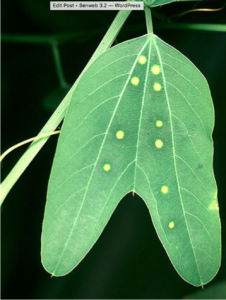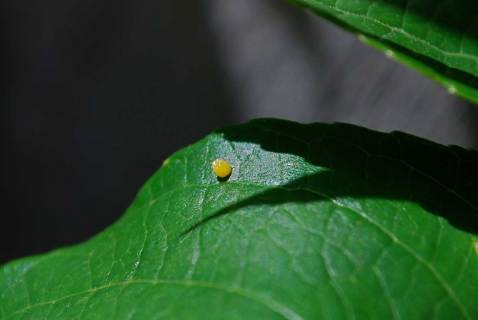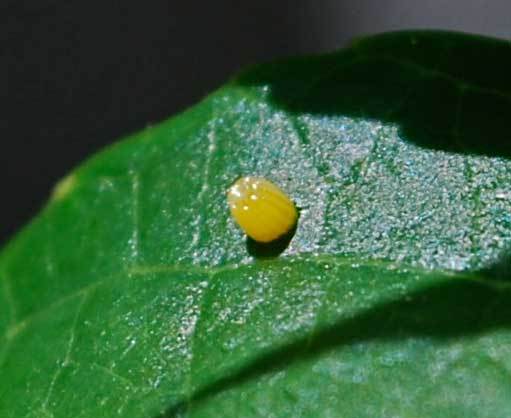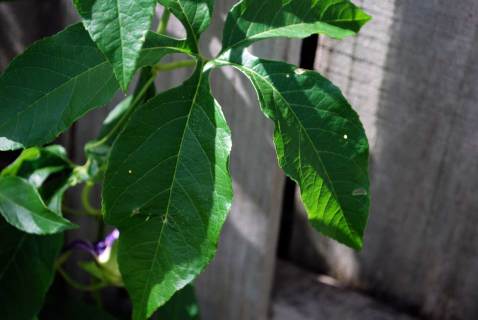Earlier this summer I posted incriminating photos of a Gulf Fritillary (Agraulis vanillae) butterfly laying eggs on my prized passionvine, Passiflora incarnata. The voracious caterpillars that spring from these eggs have been known to defoliate large vines, and mine is still young and tender, being less than three months in the ground. The other day I saw a similar event occurring and went to inspect the plant afterward (the photos of the actual event were nowhere near as good as the ones from earlier this summer, so if you want to see the cute little butterfly, I refer you to that post).
What I found was, naturally, several eggs. I counted at least five, and I probably missed many more. Here is the best close-up I could get of one of them:
Blown up as far as I can stretch it, you can almost see the beautiful fluted sides of this delicate little life capsule:
Here is a shot of an entire leaf, with two eggs on it (and a little spot that looks like an egg but isn’t):
Now, butterflies and passionvines have been coevolving for many, many years. The caterpillars would have eaten their host plant to extinction had the plants not evolved defenses against herbivory. The passionvines’ first line of defense is poison: the cyanogenic glycosides in their leaves are enough to kill most caterpillars who have the misfortune to munch on them. But a few caterpillars, the Heliconians, represented here in south Florida by three species (Agraulis vanillae, Dryas iulia, and Heliconius charithonia, aka the Gulf Fritillary, and the Julia and Zebra heliconians), have “learned” to incorporate those poisons into their own bodies without themselves falling victim to the toxins.
So these enterprising animals can dine on passionvine to their hearts’ content. And, because they are themselves poisonous, they don’t have to spend energy on camouflage, even if, unlike the Monarch larvae, they don’t bother to adopt aposematic (warning) coloration.
But the passionvine has evolved a second line of defense to discourage its would-be diners: deception. It tries to trick the adult butterfly into not laying eggs on it! It does this by exploiting a behavioral technique of the female butterfly that evolved to increase the chances of its offspring having the best access to the host plant: it only lays eggs on a plant that hasn’t got any eggs on it already. Stands to reason, right? If it already has eggs, those eggs will likely hatch before any eggs laid later, and that first brood will either, in the worst case, cannibalize any later broods, or, more likely, simply eat all the yummy bits of the plant and leave nothing but the old bitter leaves for any latecomers.
So, if the mama butterfly notices other eggs on a plant, she is likely to fly off in search of another host.
So what the passionvine does is generate “egg spots,” little yellow dots on the leaves that look like butterfly eggs! I first noticed this interesting defense a few weeks after I planted the vine; I thought the spots were a symptom of too much or too little water, or too much sun, or something. So I just monitored the plant and eventually realized they weren’t really an indication of a problem. And then it hit me: far from being a bug, these spots are a feature!
Here is a shot of one of the leaves with these “eggs” on it:
and here is a much better one from L. E. Gilbert, the author of the article cited below:

While neither the chemical defenses nor the physical defenses of this plant appear to have deterred the local butterfly population from laying their eggs on it, I have yet to find more than one or two caterpillars on it. And I don’t think I should be surprised. Nearly every time I look at this plant, there are ants patrolling almost every surface of it. Tiny little things, but my guess is they are attracted by the plant’s nectar, and they serve as yet a third line of defense against defoliation. And it appears to be working. (A recent article in Florida Entomologist [Sourakov 2008] suggests that ants prefer to patrol vines with extrafloral nectaries. P. incarnata happens to have these structures, although I’ve not witnessed any feeding behavior as yet.)
Even with common species that you see in your back yard every day, there’s always something new to learn.
References
Gilbert, L. E. (1971). Butterfly-Plant Coevolution: Has Passiflora adenopoda won the selectional race with heliconiine butterflies? Science, 172(3983):585-586. DOI: 10.1126/science.172.3983.585
Minno, M. C., Butler, J. F., and Hall, D. W. (2005). Florida Butterfly Caterpillars and Their Host Plants. Gainesville: UP of Florida.
Sourakov, A. (2008). Trophic interactions involving Herpetogramma phaeopteralis (Lepidoptera: Pyralidae) and Passiflora incarnata (Passifloraceae). Florida Entomologist, 91(1):136-138. DOI: 10.1653/0015-4040(2008)091[0136:TIIHPL]2.0.CO;2




